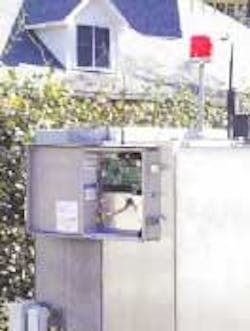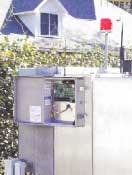Cellular System Solves Lift Station Monitoring Problems
Landis Sewerage Authority (LSA) serves the greater Vineland, NJ, area. LSA was facing some typical problems monitoring its 22 lift stations.
"Phone line problems with our autodialers were increasing almost as fast as Ma Bell's prices," said Sam Hess, Collection System Plant Manager for the 8.2 mgd authority. "Additionally, every Wednesday when we would test our stand-by generators, which tripped the autodialers, our on-call people would be swamped with phone calls."
Authority officials decided to switch to a wireless monitoring system after seeing a demonstration by Mission Communications of Atlanta, GA. The company's system uses a special cellular data technology invented by BellSouth called Cellemetry. Instead of using regular voice channels, Cellemetry uses the more reliable cellular control channels that are normally used to send call setup and billing data.
Since Cellemetry doesn't use the voice channels, it is not subject to busy signals or dropped calls, and it has wider coverage. The control channels are always on and work without actually making a phone call. Mission uses these channels to send RTU alarms, tests, and other supervisory information.
Mission management founded the first company to ever use the BellSouth technology in the burglary/fire alarm industry in 1996. It is estimated that the life/safety alarm industry alone has deployed over 150,000 devices using Cellemetry, and relies on the control channel signaling technology because of its advantages over phone lines and regular voice cellular.
With the Mission system, a central computer or SCADA software is not required. The company has its own computer facility and software in Atlanta which all customers share. Each customer is provided with a secure web site where they access their data, reports and SCADA screens.
About one second after Mission's field RTU transmits the alarm or supervisory information over the control channel to the nearest cellular tower, the data packet reaches the company's central computers.
"As fast as you can dial a long distance number and hear it ring at the other end is as fast as we get these alarms nationwide," said John Collings, President of Mission Communications.
In a fraction of a second, the computer facility converts the cellular data bytes into a text or voice message, then relays it to the customer's on-duty personnel. Mission can deliver alarm messages to regular or cellular telephones, numeric or alphanumeric pagers, can send a fax or email, or notify via the customer's web site. The system can call any number of recipients on a typical call-out list, and the list can change by time of day or day of week.
Reduced False Alarms
Since the call-out list can be changed by time of day or day of week, Mission set up LSA's system so the Wednesday stand-by generator tests were emailed to LSA, while all other alarms, or generators running at other times, were processed as full alarms with call-out.
Another problem the Mission system solved was the accidental alarms generated when personnel performed maintenance on the sites.
"The mechanics were supposed to turn off the autodialers when they were working at the stations. Either they wouldn't turn them off, causing false alarms, or they would turn them off and never turn the darn things back on, and we'd miss alarms," said Bill Quigley, LSA senior electrician.
All Mission field RTU's have electronic key readers. LSA personnel were issued small electronic keys that are weatherproof and fit easily on their key rings. The keys uniquely identify each key holder and can be used on any field RTU. Whenever anyone inspects or performs maintenance at a field station, they simply touch their key to the Mission RTU key reader. That puts the RTU in "service mode" which automatically stops alarm notifications. It also sends a message to Mission logging who checked in at the station and the time. When field technicians "key out" and leave, the RTU is put back online and another message logs the time they completed the service. If they forget to "key out", the RTU will automatically bring itself back online an hour later.
"We get fewer false alarms, better system reliability, a report we can use for the State EPA documenting when we performed maintenance and inspections, and documentation of how quickly we responded to any alarms," Hess said.
In the aftermath of the recent terrorist attacks, everyone has an increased awareness of security at all levels of water and wastewater operations. Mission and LSA are modifying the field RTUs so that electronic keys will be used to authorize entry to pump stations. The key readers will be relocated on the outside of the stations and entry intrusion detection devices added. Field personnel will use the keys to disarm RTU intrusion inputs.
Calling out alarms is just scratching the surface of what the system can do. Each night the system reports individual pump runtimes for the day, and it even keeps track of the time when pumps are running simultaneously. All the run times are logged and graphed on the customer's web site for reference and trending.
To provide additional value, the pump run times are analyzed daily for variances.
"We don't look for simple percentage changes in pump run times. We use complex statistical algorithms that take into account each pump's operational characteristics over a long period of time. When we see a change, we automatically notify the customer," Collings said.
The pump run time variance alerts are sent via fax, email or pagers during work hours if problems are detected.
"It would take us an hour or two every day to do what Mission does. It has already alerted us to several cases of operator error, bad check valves, air bound pumps and broken controllers. There are maintenance issues we're picking up now that we just never would have seen without this system. That will definitely prolong the useful life of our pumps," Quigley said.
Unexpected Savings
"We originally cost justified the Mission system on phone line savings alone (all the autodialer lines are now removed) as Mission's service price is much less expensive than a phone line. But if you take into account the man-hours the system saves us for the additional services it performs, I'd say the system actually pays for itself; essentially monitoring for free," Hess said.
Other early adopters in the New Jersey area are the Borough of Haddonfield, Egg Harbor and the City of Millville.
Mission introduced its service to the water/waste water industry over two years ago and is based in Atlanta, GA. Mission has units throughout North America from Vancouver, Canada to Miami, FL to International Falls, MN. They are represented in the New Jersey area by Deltronics in Millville, NJ.


